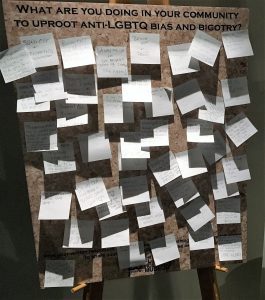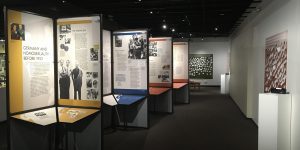The FHM’s exhibition displays a part of the evolution of strength and struggle of the LBGTQ community
 Becky Smith, Public Relations Intern at The Florida Holocaust Museum
Becky Smith, Public Relations Intern at The Florida Holocaust Museum
Due to popular demand, The FHM’s traveling exhibition, The Nazi Persecution of Homosexuals 1933-1945, has been extended through August 6, 2017. The exhibition examines the Nazi regimes attempt to eradicate homosexuality while promoting tolerance via personal stories, featured rhetoric and law of the time and interactive questions. What makes this exhibition so unique are its interactive question boards. Throughout the exhibition there’s a series of questions that visitors are free to answer and read the answers of others. Our latest question is “What are you doing in your community to uproot Anti-LBGTQ bias and bigotry?” And to my pleasant surprise, the most frequent answer was “BEING OUT AND PROUD!” Seeing people being able to be comfortable in their own skin even after being exiled and shunned is truly inspiring and uplifting.
Being that Pride month just passed, this exhibition displays a part of the evolution of strength and struggle of the LBGTQ community. Pride month is a reminder of how shame and humiliation can be turned into dignity despite what society and even government labels it. During the Nazi era, 100,000 men were arrested under violations Paragraph 175. Paragraph 175 was the law that deemed the homosexuality of men a crime from back in 1871 all the way until 1994, less than 25 years ago. Even after the end of Paragraph 175, men who were found guilty of the crime were not pardoned until 2002.
The exhibition includes what gay culture was before Hitler’s reign. Including how the community often found themselves in social clubs and halls mirroring the ones we see today. Clubs and halls are a huge part of LGBTQ culture and history. It was within those walls that people were finally able to experience liberation and feel free to express themselves. These clubs became homes to those who were otherwise kicked out of them. They could be surrounded by a cognate crowd together in a united force. In instances like Stonewall, clubs and halls are an apex of the community. That’s why tragedies like the Pulse Night Club shooting are so grievous; somewhere that’s to be used as a safe haven can be violated so quickly.
We can use The Nazi Persecution of Homosexuals 1933-1945 as a lesson of the past to further understand our present and future.


